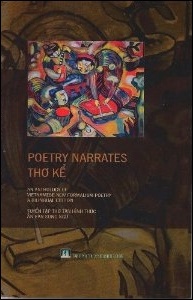|
by William Noseworthy

Khế Iêm, editor, Thơ Kể: Tuyển Tập Thơ Tân Hình Thức Ẫn Bản Song Ngữ (Poetry Narrates: An Anthology of Vietnamese New Formalism Poetry, a bilingual edition), Tan Hinh Thuc Publishing Group, 2010. 269 pgs. In Thơ Kể (Poetry Narrates), Khế Iêm offers a representative sampling of Vietnamese New Formalist Poetry (Thơ Tân Hình Thức) in both Tiếng Việt (Vietnamese) and English. In comparison to the American movement from which it draws its name, the rather successful Vietnamese New Formalist Poetry movement arose out of a distinct need to address the issue of belonging to an increasingly complex community under the umbrella of Vietnameseness. Students of Southeast Asia, Vietnam and literature will be impressed with the ease of exploration evoked by the free verse of the English sections, while readers and students of Tiếng Việt will be impressed with the trường ca, or lyrical style, relayed and made accessible. This is not to say that the poems are composed as traditional trường ca, but rather that their style is generally metered and can be very nearly sung when recited in a mellifluous fashion. Less advanced readers of Vietnamese may find it useful to read the English translations first, before immersing themselves in the Vietnamese text. Meanwhile higher level readers will still profit from having the English translations ready for reference. This anthology is organized by section, with one reserved for each of four well-regarded translators—Biển Bắc, Đỗ Vinh, Phan Khế and Trần Vũ Liên Tâm—and then broken down into subsections by poet. The advantage of this approach is that the reader can clearly discern some of the personality of the individual translators, in addition to those of the poets and poems. Stretching far beyond the already popular image of the người tau (boat people), this collection is dominated by memories of Saigon street life, reminiscent of the experience of figures such as the người ba lô (backpacker) who has the need to đi phượt (travel by motorcycle while sleeping in the open air) in order to go see the Quỳnh (blooming cactus) of the night. Major themes often include a perception of poverty, rain, loneliness and isolation. In this sense, we are seeing an emergent identity of the poetic community that stems from the successes, the trials and tribulations and the triumphant failures of life in the dusty lanes of modern Vietnam. Rural Vietnameseness, urban depressionism and international ghosts are the inquirers of these verses, which connect Saigon to Bolsa, the Vietnamese capital of Westminster Country in California. Silence is another dominant theme evoked by the conception that poets are relating the voice of the voiceless. The questions asked of Bolsa and Saigon are rarely answered, but rather left to hang in between the lines, and in this silence there is a world of imagery: of death, of mothers, of tears, of life, of ciet (small cases used by rural school children to carry books) and of holier things. It is in these translations of images that readers begin to gain an understanding of Vietnamese culture at the margins, where we are finally seeing the voice of người dân tộc (minorities) in the construction of contemporary Vietnamese identity. The Phan Khế translations of the thơ Inrasara, such as in the poem "Poisonous Dreams," place the visceral experience of the lives of the người dân tộc particularly associated with the Vietnamese Central Highlands in a context that is contemporaneous with images of the karmic cycle; "Do It Again!" where the intricacies of things Not Belonging-to-Us and those which Belong-to-Us perhaps retain a sense of Us in the Belonging since they are Not-Us, and we are told to "Seek" them out. In reflection, readers might wonder which them or its we are trying to seek. By remembering that this collection heralds poets like the recluse Trần Wũ Khang, we might see that we are simply looking at a cross section of authors who view the world through a particularly unique lens. The idea of the lens is integral to the reading of this anthology. As suggested previously, we are not only seeing the personality of terms, lines, poems and poets, but also of translators. We might also think about this project in terms of the aims of the editors and publishers as well, which stretches far beyond the visceral details of the text, to bridge nationalities, languages and generations. Thinking about these layers allows readers to see the greater significance of this anthology. Though this is a necessary addition to the collections of individuals well-versed in lịch sử văn hóa Việt Nam (Vietnamese Literary History), it also represents a key introductory text into the world of Vietnamese New Formalist Poetry. |